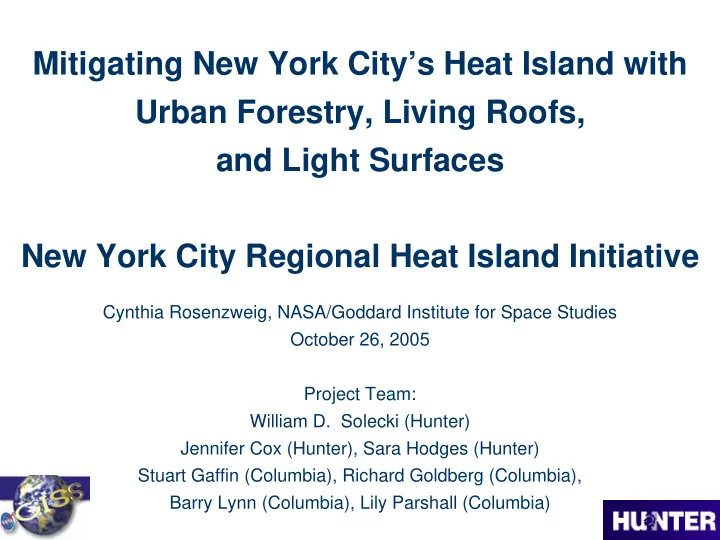

Mitigating New York City’s Heat Island with Urban Forestry, Living Roofs, and Light Surfaces New York City Regional Heat Island Initiative Cynthia Rosenzweig, NASA/Goddard Institute for Space Studies October 26, 2005 Project Team: William D. Solecki (Hunter) Jennifer Cox (Hunter), Sara Hodges (Hunter) Stuart Gaffin (Columbia), Richard Goldberg (Columbia), Barry Lynn (Columbia), Lily Parshall (Columbia)
New York City’s Heat Island Archipelago 1 km Satellite Skin Temperature NWS Observed Temperature August 14, 2002, 10:30 AM August 14, 2002, 6:00 AM 20 ( ! ( ! KPOU KMGJ 18.9 20.6 22.2 KOXC 21.1 ! ( ! ( ( ( ! ! ! ( ( ! KSWF ! ( ! ( KDXR KMMK 20 ! ! ( ( 20.6 ( ! ! ( KFWN 18.3 KBDR 23.3 ( ! ( ! ! ! ( ( KHPN 22.2 18.9 ( ! ( ! ! ( ( ! K12N KCDW 22.8 24.4 ! ! ( ( KMMU KISP 18.9 ( ( ! ! 24.4 KNYC 26.1 ! ( ( ! ! ( ( ! KFRG ( ! ( ! 23.9 ( ! ! ( 26.7 KEWR 25 ( ( ! ! ! ( ! ( 23.9 KLGA KSMQ 19.4 ( ! ( ! KJFK ( ! ( ! 22.8 ( ( ! ! KTTN KBLM 22.8 ! ( ( ! KWRI 21.1 ! ! ( ( NASA/GISS Climate Impacts Group NASA/GISS Climate Impacts Group NASA/GISS Climate Impacts Group < 24 26 28 30 32 34 36 38 40 42 44 46 48 50 52 18 19 20 21 22 23 24 25 26 27 28 Temperature (C) Tem perature (C )
Heat Island Mitigation Strategies Tree-planting in open, grassy areas Urban Forestry Tree-planting along streets to shade sidewalks and roads Living Roofs Impervious roofs covered with vegetation Impervious roofs lightened Light Surfaces All street-level and rooftop impervious surfaces lightened Combinations: Ecological Infrastructure, Urban Forestry + Light Surfaces
Data Library Observed Data • Meteorological station data from NWS and WeatherBug • Heatwave dates: July 2 – 4, July 28 – August 7, August 11 – 18 Satellite Data • 3 Landsat images (7/22, 8/14, and 9/8; 10:30 AM, 60 meters) • 1 ASTER image (9/8; 10:30 AM, 90 meters) • 1 MODIS day-night pair (9/8; 10:30 AM, 1 kilometer) GIS Data Library • Albedo composite (Source: albedo proxy based on Small, 2003) • NDVI (Source: calculated from each satellite image) • Road Density (Source: Census TIGER 2003) • Population Density (Source: Census 2000 Block Groups) • Building Square Footage (Source: Tax Parcel Database of NYC) • Average Building Height (Source: Tax Parcel Database of NYC) • Average Year Built (Source: Tax Parcel Database of NYC) • Energy Use (Source: Tax Parcel Database of NYC) Land Surface Data • Database of EMERGE aerial photography (Source: Myeong et al., 2003)
Case Study Areas Gridded surface temperature on September 8, 2002 with resolution of 250 meters. Case study areas and weather stations. Grid boxes correspond to the MM5 model 1.3 km grid. Selection criteria: [1] location within a load pocket, [2] hot spot, [3] available area Gridded NDVI with resolution of for testing a range of heat island mitigation 250 meters. strategies. Note: Lower Manhattan case study links to EPA-funded project
Base Land Surface Cover Percentages Est. Street Avail. for Level Impervious Street Grass Trees Impervious Impervious Roofs Trees Case Study Area (%) (%) (%) (%) (%) (%) New York City 14.1 21.9 64.1 45.9 18.1 17.0 Mid-Manhattan West 2.6 3.1 94.3 49.3 45.0 26.1 Lower Manhattan East 8.3 8.1 83.6 48.2 35.4 29.4 Fordham Bronx 9.2 22.1 68.7 47.1 21.5 21.1 Maspeth Queens 17.5 22.3 60.2 38.2 22.0 17.9 Crown Heights 8.1 17.2 74.7 45.6 29.1 24.9 Ocean Parkway 5.5 14.8 79.6 50.8 28.9 23.2
MM5 Regional Climate Model Mitigation Strategies MM5 v3.7+SEBM Tested 4 Ways: 1) All else being equal, absolute temperature differences between surface cover types 2) Surface type x area, with base surface and 2-meter air temperature 2-meter air 2-meter air 2-meter air temperature temperature temperature 3) Surface type x area, with sensible sensible sensible sensible latent latent sensible sensible latent latent heat flux heat flux heat flux heat flux heat flux heat flux heat flux heat flux heat flux heat flux weighted average near- Impervious Impervious Grass Grass Trees Trees Surface (skin) Surface (skin) Surface (skin) surface air temperature Temperature Temperature Temperature 4) Interactive Mitigation scenarios
Interactive Mitigation Results 100% Open Space MM5 Base Run Planting 100% Light Surfaces 100% Curbside Planting
Key Findings • Vegetation cools surfaces more effectively than increases in albedo (light-colored surfaces). • Of the mitigation strategies tested, street trees have the largest cooling potential per unit area. • Light surfaces (roofs + streets + sidewalks) offer the greatest cooling potential city-wide air temperature cooling: 1.3°F (0.7°C) on average – because there is more available area in which to implement this strategy. • Street trees have greater cooling potential than open space planting. • Living roofs have greater cooling potential than light roofs.
Case Study Results • Heat island mitigation potential is higher in Mid- Manhattan West and Lower Manhattan East because there is more available area in which to implement the mitigation strategies in these areas. • Crown Heights and Ocean Parkway, both in Brooklyn, have hotter base surface and near-surface air temperatures. Therefore the marginal benefit of implementing the strategies in these areas may be higher. • Fordham and Maspeth have moderate cooling potential.
Recommendations 1) Implement UHI mitigation strategies appropriate to conditions in individual neighborhoods and communities. 2) Plant street trees as an effective strategy for UHI mitigation in NYC. 3) Implement UHI strategies at large enough extents to be effective. 4) Monitor temperature of tree-planting programs and green roofs to observe actual mitigation levels over time. Use results to improve calibration and validation of energy balance and regional climate models. 5) Continue improving satellite data analyses, meteorological datasets, and simple energy and regional climate models to better represent urban areas.
Recommend
More recommend